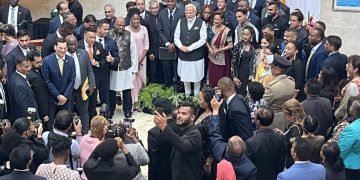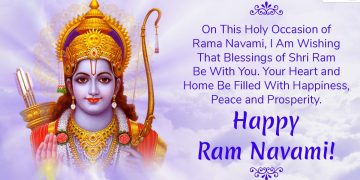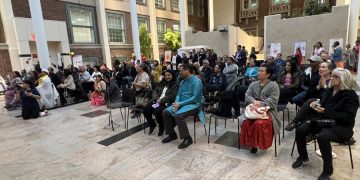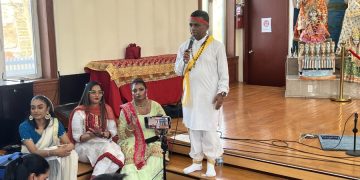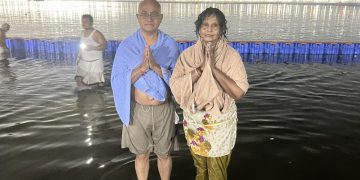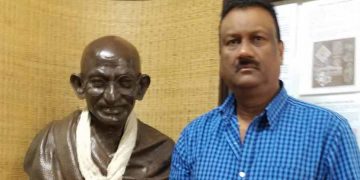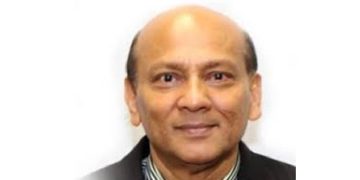Holi or Phagwah was Tuesday in Guyana and President Ali hosted magnificent celebrations at state house on night (Monday) of Holika as he did the two previous years. It is celebrated on Wednesday in several other places on the full moon this month. So wherever it is full moon, that is when it was/is observed.
Phagwah is a festival with a lot of good memories to behold. I have fond memories of celebrations in Guyana and America as well as in India and other countries. Wherever observed, it is a most wonderful, colourful, joyful, and happy celebration to experience, and I have been very fortunate to experience Holi in several countries. It is associated with playful jollification, merriment, and an assortment of dishes that are associated with the festival. It has its own unique snacks (like ghooja and gulgula) which every country seemingly has in common as I experienced.
I am celebrating Holi in India as I also did in several years gone by. This year, some places celebrated on Tuesday as in Rajasthan and on Wednesday elsewhere as in Bihar and Uttar Pradesh and the rest of India; however, in Benaras, the holy city of UP, Holi was on Tuesday.
Holika Dahaan or burning of the symbolic bad things (evil deeds and thoughts) occurred the preceding night after which was the joyful celebration. Holi is a national holiday in India similar to Guyana and a few other countries. As in Guyana, in India where the festival originated, celebrants have/had a cheerful time playing Holi (with pitchkaris and buckets of water) and feasting on goodies. Playing Holi means pouring (daubing) colorful liquid (abeer) and powder or gulal and abrack on one another. Tourists of all ethnicities partook in the festivities in India — the fun, powdered colors, merriment, and foods. Vehicles and motorcycles with celebrants moved around playing phagwah with one another. Motorcycles had three individuals mounted. Some had two adults and two children. That seems a normal mode of transport in India among the teeming masses of 1.4 billion. People were bathed with colors everywhere. With horns blowing on vehicles, celebrants pelted balloons of colorful water on passersby. On the streets, people did same somewhat similar to what celebrants do in Guyana — traditions transmitted from India to Guyana and other parts of the diaspora. No one was spared. Everyone on the streets was immersed in colors.
Phagwah in India and Guyana brings back nostalgic memories as a child or youngster. I left Guyana at age 16 to pursue university studies in medicine. I remember the fun and festivities associated with the Holi festival growing up in Ankerville, Port Mourant, village of Dr Jagan. The festival rang out weeks earlier with the ‘juking’ (rituals and planting) of Holika (dried branches and wood and other old wastes some forty days before the actual festival. Holika was planted at the ball field behind the hospital. Others were planted behind Jagan’s house and in playground in Free Yard, Bound Yard, Number 11, Haswell, Portuguese Quarter, Miss Phoebe East, Miss Phoebe West, Babu John, Tain, Clifton, Jones, and several other sub-village locations within Port Mourant. Youngsters also planted their own holika and had their own fun. There were no less than a dozen Holikas planted and even Ankerville itself had several holikas. Each area had its own gol or group (chowtaal singers and drummers) that planted the holika and would sing chowtaal nightly. Ankerville had several gols —front street, backstreet, Sideline, etc. in India, virtually every street had a Holika planted. In some neighborhoods, every block had a Holika. Neighborhood groups went around collecting donations and organized their own celebrations. In Guyana, members of gols went around soliciting donations for the holika festivities.
In Guyana, there would be chowtaal singing competition between gols. Same is the practice in the Bhojpuri belt in UP and Bihar. In Guyana, a member of each gol would host chowtaal singing inviting others to his home for chowtaal singing on weekend evening after the planting of Holika. The mandir also hosted chowtaal singing on evenings. In the village in India, gols also have chowtaal singing. The women in Guyana also had their own gol or group and did their ‘thing’ (get away). The women in the village in India also have their own groups.
In Guyana, at chowtaal functions, there would be singing and rhythmic dancing and feasting on delicacies as well as consumption of liquor by the adults. Children were happy to attend the chowtaal singing for the delicacies (bara, Channa, phulourie, pakoras, black eye, dhal puri, sweet gulgula, among other snacks and tea and coffee or kool aid. Children were strictly not offered liquor and given a sound thrashing by adults if caught imbibing. Chowtaal singing was a public event though held at a private home. Everyone was invited; none would be turned away. Holi is associated with burying bad blood. So past enmity was forgotten and people visited the host of chowtaal.
Adults would gather on the full moon night at the ball field where the holika (huge pyre) was planted, singing till midnight and then amidst chanting of mantras from the scriptures, Holika was set ablaze. The men indulged in alcohol and loud singing and consuming snacks till daylight. They sang favorite hits from the Bollywood movies. Rang Barse from Amitabh was not in vogue till the 1970s. Other hits were popular. All time favourites were: Jai Jai Shiv Shankar,
Holi Ke Din Dil Mil Jaate Hai (Sholay), Aaj Na Chodengey Tujhe… Dum Duma Dum!, Holi Khele Raghubeera Awadh Me, and more. Chowtaal was very popular.
The men mixed water with ashes from the fire and poured on one another. Several groups would sing chowtaal around the fire. Gols took turn singing. The night rang with loud music from the Jamal, dholak, tarapiti, and other instruments throughout the night. Children were not allowed at the burning of holika. Children gathered with the females who had their own chowtaal singing, feasting and drinking the night away. As a child, I accompanied my sisters as did other kids with female kins. Some youths burned their own holika in the streets.
The men as a large group of hundreds slowly made their way through the village singing and playing appropriate music. People would come out of their houses on the streets to join the men in playing Phagwah — throwing water, mud, crowding, etc on one another. Some families invited the men into their yards for drinks and snacks and singing. Tummies were filled. The youths drooled over snacks. Ghoojas or gujiyas and gulgula with raisins were served with hard and soft beverages. Channa and other snacks were also served until they were outlawed by the government and placed on the prohibited food list. Many foods associated with the festival were placed on the banned goods list and if caught in possession or consuming them led to fines and jail time. There were loads of sweets including payra, barfi, ladoo, kheer, mitai, among others.
Holi was also associated with youths and they did their own thing. On the last day of high school, students soaked each other or three each other in a trench. Students made sure they wrapped their books in plastic for protection from liquid. Groups were formed to wet others. Boys would pick on the females especially if they liked of attracted to someone.
Holi was a time for youngsters to flirt with girls. The boys visited the home of prospective girlfriend. It was an occasion to visit the home of unsuspecting parents that the boy and girl like or were attracted to one other. They played Phagwah at the home of the female. I would roam around with friends playing Phagwah from village to village. We were armed with pitchkaris or spray bottles. And I observed the same in India with children and adults having a fun time shooting liquid at others. People on foot played Holi in the streets and vehicles moved slowly in the streets of cities as well as rural areas frolicking in Phagwah. They are discolored with artificial colors not different from Guyana on Phagwah.
There were two parts to the Holi celebration. The ‘nasty’ or rough part in the morning and ‘cleaner’ or gentler part in the afternoon. The nasty part is the dirty water or polish and thick colorful powder roughly placed on celebrants. The cleaner part is the light red liquid and or white talc powder and or soft colorful abrack and gulal powder placed gently on the other. In the morning, people went house to house playing rough. Then they bathed and cleansed themselves. In the afternoon, they dressed in white and went around to selected houses armed with abeer bottles and powder playing gently. It was lively and fun.
As I traversed the streets in India, I reminisced of the wonderful childhood memories in my beloved Guyana. Guyanese transplanted the festival in various cities in America, Canada, and UK. And traditions have taken hold among them diasporans in these countries as well. But the endless possibilities of celebration in Guyana and mother land India or in Trinidad and Suriname are not the same in the diaspora. But the memories of a wonderful festival linger.

















